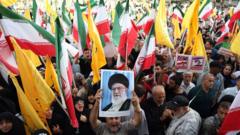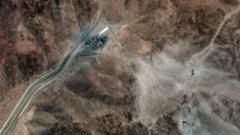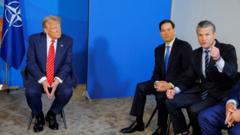After extensive attacks and escalating military confrontation, a ceasefire was achieved between Iran and Israel, mediated by the U.S. This dramatic turn unfolded over a turbulent day with missile strikes, warnings, and diplomatic endeavors, showcasing the intricate dynamics of Middle Eastern geopolitics.
Tensions Eased: The Rapid Shift Toward a Ceasefire between Iran and Israel

Tensions Eased: The Rapid Shift Toward a Ceasefire between Iran and Israel
A chaotic 24-hour period saw the U.S. intervene to mediate a ceasefire between Iran and Israel amidst escalating military tensions and strikes.
Since mid-June, the ongoing conflict between Israel and Iran has resulted in significant strikes on military sites from both sides, as the U.S. military also targeted Iranian nuclear facilities. However, a flurry of events led up to a ceasefire agreement stimulated by U.S. diplomatic intervention.
On Monday, as warnings were issued for U.S. citizens in Qatar to "shelter in place," tensions heightened in the region. The al-Udeid airbase, crucial for U.S. operations, was deemed under threat from Iran as missile launchers were reportedly positioned toward the base. U.S. officials confirmed a "credible threat" arising from these preparations, leading to restrictive airspace measures over Qatar.
As explosions erupted and Iranian state media confirmed missile actions against the U.S. base, Qatar's government condemned the Iranian aggression. The strikes reportedly, however, did not result in any casualties, indicating a possible de-escalation designed to allow Iran to save face without sparking a broader conflict.
Simultaneously, U.S. President Donald Trump projected a shift in his tone during social media communications, suggesting that perhaps it was time for reconciliation in the region. Amidst a crucial call between Trump and Israeli Prime Minister Benjamin Netanyahu, pressure mounted for a resolution. U.S. negotiators engaged in backchannel talks with Iranian officials, advocating for a ceasefire.
Despite a grim early morning in Israel marked by multiple missile warnings and casualties, including a hit residential building in Beersheba, the ensuing U.S.-facilitated ceasefire began to take root. Official announcements came through from both the U.S. and Israel, with conditions easing for a potential resolution moving forward.
However, hostilities peaked again shortly after the ceasefire agreement, as Israeli air defenses responded to new missile threats from Iran. President Trump’s intervention was critical as he urged restraint amidst further military engagement, stressing the importance of maintaining the ceasefire arrangements.
As developments unfolded, the conflicting emotions and aggressive posturing from both sides showcased the complexity of Middle Eastern geopolitics. The paths to peace remain fraught with challenges, but the swift shifts observed in these tumultuous hours may redefine the future landscape of conflict in the region.























